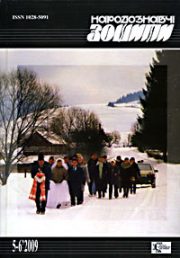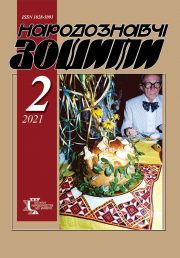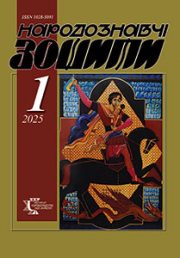The Ethnology Notebooks. 2021. # 2 (158), P. 440—450
УДК 741(477)”1941/1945″
DOI https://doi.org/10.15407/nz2021.02.440
Yuliya MAYSTRENKO-VAKULENKO
- ORCID ID: https://orcid.org/0000-0002-9796-7781
- Candidate of Art History, Associate Professor,
- Head of Department of Scenography and Screen Arts,
- National Academy of Fine Art and Architecture,
- Voznesensky Descent, 20, Kyiv, 04053, Ukraine,
- e-mail: ymaystrenko-v@ukr.net
DRAWING OF UKRAINIAN ARTISTS DURING EVACUATION (1941—1945)
Problem statement. During the Second World War, drawing became one of the dominant arts, along with propaganda graphics and posters. The flowering of this art in the works of many artists of the war period was possible not only due to the technical availability of drawing materials, but, primarily, the intimacy, individuality, and special privacy of drawing. Various life circumstances: serving under the conditions of front, rear or occupation caused certain differences in the style, genre and drawing technique of Ukrainian artists. Most previous studies tend to consider the drawing heritage of artists of the war period in a generalized sense, without emphasizing the difference between the work of artists during evacuation and those serving at the front.
The purpose of the paper is to determine the circle of Ukrainian artists; study the genre, artistic and stylistic structure, as well as materials and techniques of drawings created by artists of those years; identify peculiar properties of the reproduction of temporal and spatial categories in the drawings of Ukrainian artists during evacuation.
The methodology of the paper rests upon the principles of historicism. A combination of comparative, historical and cultural and contextual scientific methods, as well as figurative and stylistic, systematic and comparative analysis, has been applied.
Scientific novelty. The main genres the artists tend to use during evacuation were landscape and portrait, and the dominating means of expression was the tone. The only exception to the above is the work of Kost Yeleva, a student of Mykhailo Boychuk, for whom a constructive, laconic line has always been the foundation for creating an image. The works of some artists, who were in the republics of Central Asia, in particular Vasyl Kasiyan, had the features of ethnography. Conclusions. It was drawing that became the sphere in which artists felt as free as possible to express their creative individuality in the hard times of evacuation. Kost Yeleva, Vasyl Kasiyan, Karpo Trokhymenko, Oleksiy Shovkunenko, Oleksandr Pashchenko, Ibrahim Litynskyi, Ilarion Pleshchynskyi, Havrylo Pustoviyt, Yosyp Daits, Khaim Freidin, Oleksandr Postel, Leopold Levytskyi, Borys Pianida, Mykola Riabinin, and Valentyn Bunov played an important role in the development of drawing art. The only possible style of those days, socialist realism, realized in the front-line sketch primarily in the fixation of the moment and a certain frame, gained greater emotional depth and duration in the drawings of evacuated artists.
Keywords: Ukrainian drawing; sketch, Second World War; evacuation; portrait; landscape; genre.
REFERENCES
- Roghotchenko, O.O. (2007). Socialist Realism and Totalitarianism. Kyiv: Feniks [in Ukrainian].
- Lagutenko, O.A. (2006). Ukrainian Graphic Art of the First Third of the 20th Century. Kyiv: Grani-T [in Ukrainian].
- Sydorenko, V.D. (2008). Visual Art from Avant-Garde Shifts to the Latest Trends: The Development of Visual Art in Ukraine in 20t —21st Centuries. Kyiv: BX [Studio] [in Ukrainian].
- Rohotchenko, O.O. (2010). Skulptor Ivan Makogon. MIST (Issue 7, pp. 323—331) [in Ukrainian].
- Nikitin, D. (2016). To the Creative Biography of the Master. (Memoirs of Hilarion Pleshchynsky’s Wife Sofia Prokhoda). Fine Art, 1, 100—103 [in Ukrainian].
- Kryvolapov, O. (2006). About Art and Art Criticism of Ukraine of the 20th Century. Kyiv: Vyd. Dim A+S [in Ukrainian].
- Letters to Shovkunenko O.O. Tsybulnyk I. The roster of Artists of Ukraine, members of the Union of Artists with addresses is attached (1942—1945). Unpublished manuscript. F. 658. Оp. 1. Spr. 180. CSAMLA of Ukraine. Kyiv [in Russian].
- (1943). Letters of Averin V.H. to Petrytsky A.H. Unpublished manuscript. F. 237. Op. 2. Spr. 214. CSAMLA of Ukraine. Kyiv [in Russian].
- Bohutskyi, Yu. (2012). Ukrainian society of the first half of the twentieth century in terms of organization and self-organization of cultural and artistic activities. The Culturology Ideas, 5, 7—12 [in Ukrainian].
- Diary «Artist’s Notebook» (1933—1942). Unpublished manuscript. F. 290. Op. 1. Spr. 139. CSAMLA of Ukraine. Kyiv [in Russian].
- Diary «Artist’s Notebook». (1942). Unpublished manuscript. F. 290. Op. 1. Spr. 140. CSAMLA of Ukraine. Kyiv [in Russian].
- Letters to Shovkunenko O.O. of Khytrova T.O. Drawings are attached. (1942—1943). Unpublished manuscript. F. 658. Op. 1. Spr. 179. CSAMLA of Ukraine. Kyiv [in Russian].
- Kasiyan, V. (2004). Self-Portrait. Kyiv: Veselka [in Ukrainian].
- Onyshhenko, O.S. (Ed.). (2007). History of the National Academy of Sciences of Ukraine. 1941—1945 (Part 1). Documents and materials. Kyiv: National Academy of Science of Ukraine [in Ukrainian].
- Letters of the Fundraiser Pleschynsky I.M. to M.I. Gelman. Unpublished manuscript. F. 183. Оp. 2. Spr. 60. CSAMLA of Ukraine. Kyiv [in Russian].
- Pustoviit, O., & Pustoviit, H. (Eds.). (2004). Gavrylo Pustoviyt. 1910—1947. Catalog. Kyiv: L-Trafiko [in Ukrainian].
- Shovkunenko Oleksiy (1884—1974) Ukrainian Artist. Unpublished manuscript. F. 658. Op. 1. Foreword. CSAMLA of Ukraine. Kyiv [in Ukrainian].
- Certificate of the Deputy Head of the Department for Art at the CPC. (1942, 1944). F. 117. Op. 1. Spr. 130. CSAMLA of Ukraine. Kyiv [in Russian].
- Trokhymenko Karpo Demianovych — Ukrainian Soviet Artist (1915—1967). F. 61. Op. 1. Spr. 1—89. CSAMLA of Ukraine. Kyiv [in Ukrainian].
- From the Series «War» (1941—1942). F. 658. Op. 1. Spr. 40. CSAMLA of Ukraine. Kyiv [in Ukrainian].
- Pavlova, O. (2018). Review of new receipts of documents to the CSAMLA of Ukraine for 2017. Archives of Ukraine, 4, 103—114 [in Ukrainian].
- Kodeva, E. (Ed.). (2012). Kodiev Peter Ivanovich: Life and work. Creative heritage. Relatives, friends, contemporaries. Kyiv: AlMaks [in Russian].
- Landscapes of the cities of Zagorsk, Kyiv and Samarkand (1934—1960). F. 1108. Op. 1. Spr. 1. CSAMLA of Ukraine. Kyiv [in Ukrainian].
- (1942). Self-Portrait. F. 56. Op. 1. Spr. 11. CSAMLA of Ukraine. Kyiv [in Ukrainian].
- Maystrenko-Vakulenko, Yu. (2019). Drawing Heritage of Professor of the Kyiv State Art Institute Konstantin (Kost) Eleva. Visnyk Lvivskoi natsionalnoi akademii mystetst, 49, 46—54 [in Ukrainian].
- Spivak, L., & Korytska-Holub, Yu. (2016, april 18). Leopold Levitsky is a Modernist Graphic Artist from Chortkiv. Zaxid.net. Retrieved from: https://zaxid.net/leopold_levitskiy_grafikmodernist_z_chortkova_n1389146 (accessed 23.02.2021) [in Ukrainian].
- Zhmurko, О. (2016). Creative heritage of Leopold Levytsky: (dedicated to the 110-th anniversary of birth of the artist. Visnyk Lvivskoi natsionalnoi akademii mystetstv (Issue 30, pp. 363—372).
- «Dream», «Uzbek», «Uzbek boy» and others. From a series of sketches «Tashkent» (1942—1943). F. 493. Op. 1. Spr. 2. CSAMLA of Ukraine. Kyiv [in Ukrainian].
- (1944). Letters to Shovkunenko O.O. of Freidin. Unpublished manuscript. F. 658. Op. 1. Spr. 176. CSAMLA of Ukraine. Kyiv [in Russian].
- Сhatsky, A. (2014). Strive from Soul to Soul. Migdal, 132. Retrieved from: https://www.migdal.org.ua/times/132/ 30933/ (accessed 23.02.2021) [in Russian].
- (1943). Portret Lysenka H.M. F. 268. Op. 1. Spr. 11. CSAMLA of Ukraine. Kyiv [in Ukrainian].
- Kharkiv State Academy of Design and Fine Arts. Museum of KhSADA. Retrieved from: https://ksada.org/museum-besedin.html (accessed 23.02.2021) [in Ukrainian].
- Berkovych Hryhorii. House «The Word». Retrieved from: http://proslovo.com/person/47-175-berkovich-grygoriy (accessed 23.02.2021) [in Ukrainian].
- Varych, M. (2011, january 29). Epstein Drew Women with Masculine Features. Gazeta.ua. Retrieved from:https://gazeta.ua/articles/culture-newspaper/_epshtejn-malyuvav-zhinok-z-cholovichimi-risami/369136 (accessed 23.02.2021) [in Ukrainian].
- «Knitting», «Boy Kyrgyz» and others. (1940-s). F. 436. Op. 1. Spr. 2. CSAMLA of Ukraine. Kyiv [in Ukrainian].
- Bogomazov, O. (1996). Line. Painting and Elements (Pp. 43—51). Kyiv: Zadumlyvyi straus [in Ukrainian].
- Kandinsky, W., & Kozina, E. (2018). Point and Line to Plane. Reflections on Art (Pp. 165—306). Moskva: AST [in Russian].






